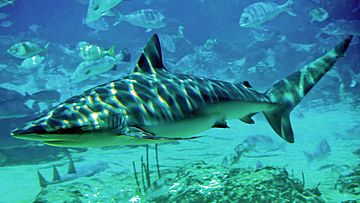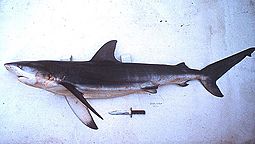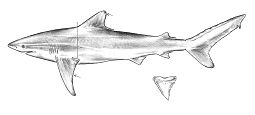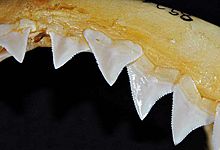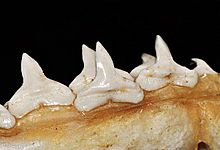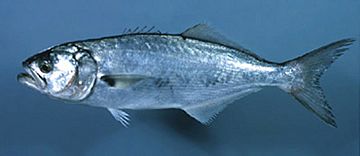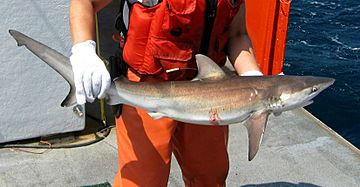Dusky shark facts for kids
Quick facts for kids Dusky shark |
|
|---|---|
 |
|
| Conservation status | |
| Scientific classification | |
| Genus: |
Carcharhinus
|
| Species: |
obscurus
|
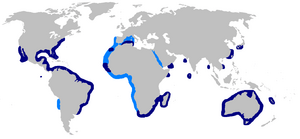 |
|
| Confirmed (dark blue) and suspected (light blue) range of the dusky shark | |
| Synonyms | |
|
Carcharhinus iranzae Fourmanoir, 1961 *ambiguous synonym |
|
The dusky shark (Carcharhinus obscurus) is a type of requiem shark. These sharks live in warm oceans all around the world. They are apex predators, meaning they are at the top of their food chain.
Dusky sharks live near coasts, over the continental shelf, and in open ocean waters. They can be found as deep as 400 meters (1,300 feet). These sharks travel long distances, moving towards cooler areas in summer and warmer areas in winter. They can travel thousands of kilometers!
This shark is one of the biggest in its family. It can grow up to 4.2 meters (14 feet) long and weigh 347 kilograms (765 pounds). You can spot a dusky shark by its short, round snout and long, curved pectoral fins. It also has a ridge between its two dorsal fins.
Adult dusky sharks eat many different things. Their diet mainly includes bony fish, other sharks and rays, and cephalopods like squid. They also sometimes eat crustaceans, sea turtles, and even dead marine mammals.
Dusky sharks give birth to live young, like mammals. Females have a baby every three years. They carry their babies for 22–24 months. After giving birth, they rest for a year before getting pregnant again. Females can store sperm for a long time. This helps them have babies even if they don't meet a male shark often. Dusky sharks grow very slowly. They don't become adults until they are about 20 years old.
Because they grow and reproduce so slowly, dusky sharks are easily affected by overfishing. People value them for their fins, meat, skin, and liver oil. The International Union for Conservation of Nature (IUCN) lists the dusky shark as Endangered worldwide. This means their numbers are very low. Off the eastern United States, their population has dropped a lot since the 1970s. Dusky sharks are large, so they could be dangerous to humans. However, there are very few recorded shark attacks from them.
Contents
Discovering the Dusky Shark
The dusky shark was first described by a French naturalist named Charles Alexandre Lesueur. He wrote about it in 1818. He named it Squalus obscurus, with "obscurus" meaning "dark" or "dim" in Latin. This name refers to its color. Later, scientists moved it to the genus Carcharhinus.
This shark has many other common names. Some people call it the bay shark, brown shark, or common whaler.
Where Dusky Sharks Live
Dusky sharks live in warm waters around the world. You can find them in the western Atlantic Ocean, from Massachusetts to southern Brazil. They are also in parts of the eastern Atlantic, like off the Canary Islands and Senegal. In the Indian Ocean, they live off South Africa and Mozambique. In the Pacific Ocean, they are found off Japan, China, Australia, and California.
These sharks prefer water temperatures between 19 and 28 degrees Celsius (66-82 degrees Fahrenheit). They avoid areas where the water is not very salty, like estuaries.
Dusky sharks are always on the move. They can travel up to 3,800 kilometers (2,360 miles)! Sharks off North America move north in summer and south in winter. Young sharks in South Africa also move around as they grow.
What Dusky Sharks Look Like
The dusky shark is one of the biggest sharks in its group. It usually grows to about 3.2 meters (10.5 feet) long and weighs 160–180 kilograms (350-400 pounds). The biggest one ever recorded was 4.2 meters (14 feet) long and weighed 347 kilograms (765 pounds). Female sharks tend to be larger than males.
This shark has a sleek, long body. Its snout is wide and rounded. It has medium-sized, round eyes with special protective eyelids called nictitating membranes. Its mouth has 13-15 rows of teeth on each side of both jaws. The upper teeth are wide, triangular, and have jagged edges. The lower teeth are narrower and straighter.
Its large pectoral fins are curved like a sickle. The first dorsal fin is also curved and sits right above the tips of the pectoral fins. A small ridge runs along its back between the two dorsal fins. The caudal fin (tail fin) is large and high.
Dusky sharks are bronze to bluish-gray on top and white underneath. They have a faint lighter stripe along their sides. Their fins, especially the undersides of the pectoral fins and the lower part of the tail fin, get darker towards the tips. This is easier to see in young sharks.
Dusky Shark Life and Habits
Dusky sharks are at the top of the food chain. This means they are generally less common than other sharks. However, many young sharks can gather in certain places. Adult sharks sometimes follow ships far out at sea. They swim at an average speed of about 0.8 kilometers per hour (0.5 miles per hour).
Other animals sometimes live on dusky sharks. For example, the sharksucker fish often attaches to them. Dusky sharks can also have parasites like tapeworms and leeches.
Adult dusky sharks do not have many natural enemies. But young sharks can be eaten by bigger sharks. These include the ragged tooth shark, great white shark, bull shark, and tiger shark. In some areas, shark nets used to protect beaches have reduced these large predators. This has led to more young dusky sharks, which then eat many small bony fish. This can affect the balance of the local ecosystem.
What Dusky Sharks Eat
Dusky sharks are not picky eaters. They hunt many different kinds of prey from all parts of the ocean, but they especially like hunting near the bottom. A large shark can eat more than a tenth of its own weight in one meal! The bite force of a 2-meter (6.6-foot) dusky shark is very strong. It's one of the strongest bites measured for any shark.
Their diet includes:
- Ocean fish: like herring, tuna, mackerel, and billfish.
- Bottom fish: like mullets, eels, and flatfish.
- Reef fish: like barracudas and groupers.
- Cartilaginous fish: like other small sharks, skates, and stingrays.
- Invertebrates: like cephalopods (squid, octopus) and crustaceans.
Very rarely, the largest dusky sharks might eat sea turtles or dead marine mammals. They have even been found with human trash in their stomachs.
In the northwestern Atlantic, about 60% of their diet is bony fish. Bluefish and summer flounder are very important foods there. In South Africa and Australia, bony fish are also their main food. Young sharks eat small prey like sardines and squid. Older sharks eat bigger fish and other sharks.
Dusky Shark Life Cycle and Reproduction
Like other requiem sharks, dusky sharks give birth to live young. The baby sharks grow inside the mother. They get food from a yolk sac at first. Then, a special connection like a placenta forms to feed them.
Mating usually happens in spring in the northwestern Atlantic. Female sharks can store sperm for a long time, even for years. This is helpful because they travel a lot and might not meet a male shark often.
Female dusky sharks have babies only once every three years. They are pregnant for 22–24 months. Then, they rest for a year before getting pregnant again. A female usually has 6 to 12 pups in a litter, but it can be anywhere from 3 to 16.
Newborn dusky sharks are about 0.7 to 1.0 meters (2.3-3.3 feet) long. They are born in shallow areas like lagoons. These places offer plenty of food and protection from predators, including other sharks. The mother sharks leave the nursery areas right after giving birth.
| Region | Male length and age at maturity | Female length and age at maturity |
|---|---|---|
| Northwestern Atlantic | 2.80 m (9.2 ft), 19 years | 2.84 m (9.3 ft), 21 years |
| Eastern South Africa | 2.80 m (9.2 ft), 19–21 years | 2.60–3.00 m (8.53–9.84 ft), 17–24 years |
| Indonesia | 2.80–3.00 m (9.19–9.84 ft), age unknown | 2.80 m (9.2 ft), age unknown |
| Western Australia | 2.65–2.80 m (8.7–9.2 ft), 18–23 years | 2.95–3.10 m (9.7–10.2 ft), 27–32 years |
Dusky sharks grow very slowly. They reach sexual maturity (adulthood) at a large size and old age. For example, in the northwestern Atlantic, males become adults around 19 years old, and females around 21 years old. Their growth rate is about 8–11 centimeters (3-4 inches) per year for the first five years. They are believed to live for 40–50 years or even longer.
Dusky Sharks and People
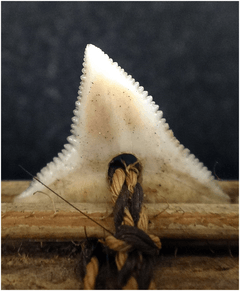
Are Dusky Sharks Dangerous?
Dusky sharks are large, so they could be seen as dangerous. However, not much is known about how they act around people underwater. As of 2009, there have been six reported attacks on people or boats linked to dusky sharks. Three of these were unprovoked, and one was fatal. But some attacks thought to be from dusky sharks might have actually been from Galapagos sharks.
Fishing and Conservation
Dusky sharks are very valuable in the fishing industry. Their large fins are used for shark fin soup. Their meat is sold fresh, frozen, or dried. Their skin is used for leather, and their liver oil is used for vitamins.
Commercial fishing boats catch dusky sharks using longlines and gillnets. This happens off eastern North America, southwestern Australia, and eastern South Africa. In southwestern Australia, the fishery catches mostly young sharks under three years old.
Dusky sharks are also caught by accident (called bycatch) by boats fishing for tuna and swordfish. Recreational fishers also catch many dusky sharks, especially young ones. This shark used to be a popular catch in shark fishing tournaments in Florida.
Protecting Dusky Sharks
The International Union for Conservation of Nature (IUCN) has listed the dusky shark as Endangered worldwide. This is because they reproduce so slowly, making them very sensitive to overfishing.
Off the eastern United States, dusky shark numbers are very low. A survey in 2006 showed that their population had dropped to only 15–20% of what it was in the 1970s. Because of this, catching dusky sharks for commercial or recreational purposes was banned in 1998. However, many sharks are still caught by accident.
Scientists are working to help conserve these sharks. They have developed ways to identify shark parts, like fins, using DNA. This helps them check if the parts come from protected species like the dusky shark.
Images for kids
See also
 In Spanish: Tiburón arenero o Jaquetón lobo para niños
In Spanish: Tiburón arenero o Jaquetón lobo para niños



